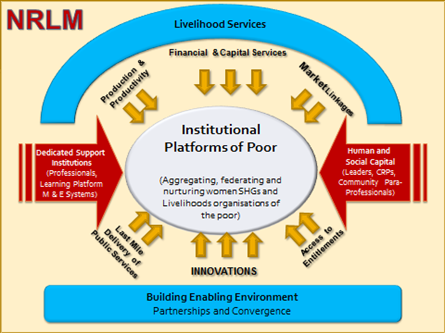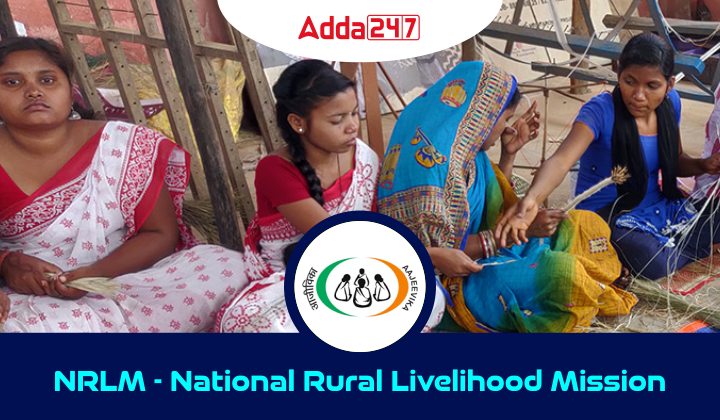Table of Contents
The primary poverty reduction initiative of the Ministry of Rural Development is the Deendayal Antyodaya Yojana – National Rural Livelihoods Mission (DAY-NRLM). This flagship program aims to empower the impoverished, particularly women, through the establishment of robust institutions that can access financial services and livelihood opportunities. DAY-NRLM adopts a demand-driven approach, allowing states to formulate customized poverty reduction plans based on their specific requirements.
Intensive blocks and districts receive comprehensive components of DAY-NRLM through various implementing bodies, while others are categorized as non-intensive. The National Rural Livelihood Mission (NRLM) represents an enhanced iteration of the Swarnajayanti Gram Swarojgar Yojana (SGSY). On March 29, 2016, NRLM was renamed DAY-NRLM in honour of Deendayal Antyodaya.
Latest Updates of NRLM
- During October 4th and 8th, 2021, 152 Centres for Financial Literacy & Service Delivery (SAKSHAM Centres) were inaugurated across 77 districts in 13 states under the Azadi ka Amrit Mahotsav, as part of the Deendayal Antyodaya Yojana – National Rural Livelihoods Mission (DAY-NRLM) led by the Ministry of Rural Development.
- SAKSHAM Centres aim to provide financial literacy and facilitate the delivery of financial services to members of Self-Help Groups (SHGs) and the rural poor.
- Centre for Financial Literacy & Service Delivery (CFL&SD) functions as a one-stop solution/single window system catering to the basic financial needs of households belonging to Self-Help Group (SHG) in rural areas.
- These Centers are administered by the SHG network, primarily at the level of Cluster Level Federations (CLFs), and are supported by trained Community Resource Persons (CRPs).
Deen Dayal Antyodaya Yojana (DAY-NRLM)
The DAY-NRLM serves as a fundamental poverty alleviation initiative of the Central government. Originally introduced as the ‘Aajeevika – National Rural Livelihoods Mission (NRLM)‘ by the Ministry of Rural Development of the Government of India in 2011, it underwent a name change to DAY-NRLM in 2015.
This program represents an enhanced iteration of the former Swarnjayanti Gram Swarozgar Yojana (SGSY).
- Partial support for the program is provided by the World Bank.
- The primary goal is to establish efficient institutional platforms, facilitating increased household income for the rural poor through sustainable livelihood enhancements and improved access to financial services.
- The program also focuses on empowering the impoverished to access their rights, public services, and other entitlements.
- The mission aims to tap into the inherent capabilities of the poor, providing them with essential resources such as knowledge, information, tools, finance, skills, and encouraging collectivization to actively participate in the economy.
- Initially designed to cover 7 Crore rural poor households through Self Help Groups (SHGs) and federated institutions over 8-10 years.
- In 2021, the Union Cabinet approved a special package of Rs. 520 crore for a five-year period (until the financial year 2023-24) under the Deendayal Antyodaya Yojana-National Rural Livelihood Mission (DAY-NRLM) in the Union Territories of Jammu and Kashmir (J&K) and Ladakh.
- The decision aligns with the government’s objective to universalize all centrally sponsored beneficiary-oriented schemes in Jammu & Kashmir and Ladakh within a specific timeframe.
NRLM Mission
“To help poor families find good work for themselves and learn useful job skills, so they can improve their lives in a lasting way. This is done by creating strong community groups for the poor.”
Principles to Follow in NRLM:
- Poor people really want to overcome poverty, and they have natural abilities.
- We need to bring out the skills of the poor by creating strong community groups.
- To achieve this, we require external support that is committed and understanding, helping with social mobilization and institution-building.
- To move upward, we focus on:
-Sharing knowledge
-Developing skills
-Providing access to credit
-Facilitating access to markets
-Ensuring access to livelihood services.
NRLM Core Values:
- Involving the most impoverished and assigning them significant roles in every process.
- Ensuring accountability and transparency in all institutions and processes.
- Fostering community self-dependence and self-reliance.
- Advocating for the ownership and active participation of the poor in all their institutions, encompassing planning, execution, and monitoring.

Features of NRLM
The primary aspects of the program include:
- Universal social mobilization: Involves bringing at least one female member from a rural poor household, with a focus on marginalized sections, into the Self-Help Group (SHG) network.
- Participatory Identification of Poor: Engages the community in identifying those in need.
- Community Funds as Resources in Perpetuity: Strengthens the financial management capacity of the poor by utilizing community funds as lasting resources.
- Financial inclusion: Aims to include the poor in the formal financial system.
- Livelihoods: Focuses on enhancing and stabilizing the existing livelihood structures of the poor through three pillars:
Vulnerability reduction & Livelihoods enhancement: Expanding current livelihoods and exploring new opportunities in both farm and non-farm sectors.
Employment: Building skills for better employment opportunities.
Enterprises: Promoting self-employment. - Emphasis on convergence and partnerships: Prioritizes collaboration with other government schemes of the Rural Development Ministry.
- Linkages with Panchayati Raj institutions: Seeks to establish connections with local self-government institutions.
Eligibility for DAY-NRLM
- SHGs need to demonstrate activity for the last 6 months based on financial records, not just since the initiation of their savings account.
- SHGs are required to adhere to the ‘Panchasutras,’ encompassing regular meetings, savings, inter-loaning, timely repayments, and maintaining up-to-date account books.
- Qualification criteria set by NABARD for grading must be met by SHGs.
- If SHG federations are established, they can conduct grading assessments to assist banks.
- Even previously inactive SHGs can be eligible for credit if they are revived and remain active for at least 3 months.
Functions of NRLM
- NRLM empowers SHG members by enhancing their communication skills and facilitating better access to quality services like healthcare and education.
- NRLM adopts a demand-driven approach, allowing states the autonomy to design their own poverty reduction plans focusing on livelihoods.
- Allocation of resources is determined based on poverty ratios among states.
- Planning and implementation at the district level are supervised by the District Mission Management Unit (DMMU), reporting to the district government.
- The Block Mission Management Unit oversees implementation at the block level, with a specific number of blocks completed each year.
- NRLM aims to mobilize all rural poor households by the year 2023-24.
- The Department of Rural Development, Ministry of Rural Development, Government of India, handles policy formation, program monitoring, evaluation, and fund release.
Sub-schemes under NRLM
The National Rural Livelihoods Mission (NRLM) encompasses various sub-schemes that are executed across different states in India. These initiatives are crafted to offer a variety of services and assistance to uplift the rural poor.
Aajeevika Grameen Express Yojana (AGEY)
- Launched in 2017.
- Goal: To create alternative livelihood opportunities for Self-Help Group (SHG) members within the main scheme.
- Objective: Enable SHG members to provide public transport services in economically disadvantaged rural areas.
- Features: Offers affordable, safe, and community-monitored rural transport services.
- Purpose: Connects remote villages with essential amenities and services, including healthcare, markets, and education.
- Impact: Aims to contribute to the overall economic development of the region.
Mahila Kisan Sashaktikaran Pariyojana (MKSP)
- Primary objective: Empower women in agriculture through systematic investments to boost their participation and productivity.
- Goal: Create and sustain agriculture-based livelihoods for women in rural areas.
- Additional objectives:
-Ensure food and nutrition security in households.
-Facilitate improved access to services and inputs for women in agriculture.
-Enhance the managerial capabilities of women involved in agriculture.
Start-up Village Entrepreneurship Programme (SVEP)
- Objective: Promote startups in rural areas.
- Key challenges addressed for rural startups:
Lack of a knowledge ecosystem.
Absence of a financial ecosystem.
Lack of an incubation ecosystem. - The vision of SVEP (Sub-scheme name): Generate sustainable self-employment opportunities for rural poor youth.
- Goal: Enable effective engagement with the market, leading to local wealth generation.
National Rural Livelihoods Project (NRLP)
- The NRLP is structured to establish a ‘proof of concept’ and enhance capabilities at both central and state levels. Its objective is to create a facilitating environment, enabling all states and Union Territories (UTs) to transition to the NRLM.
Rural livelihood is a significant subject in the UPSC CSE exam. Thus, it is crucial to address various aspects of rural livelihood, encompassing its definition, improvement, and government interventions aimed at its enhancement.
Support Provided under DAY-NRLM Scheme
- NRLM is centrally financed, with the current funding split between the state and center at a ratio of 75:25.
- For special category states (Arunachal Pradesh, Assam, Manipur, Meghalaya, Mizoram, Nagaland, Sikkim, Tripura, Jammu & Kashmir, Himachal Pradesh, and Uttarakhand), the funding ratio shifts to 90:10 between the Center and States.
- Money is sent to the states through NRLM and State Rural Livelihood Mission (SRLM), which must notify and open a bank account.
- The SRLM disburs funds to the districts following the allocations outlined in the Annual Action Plan.
- District-level consolidated data is utilized to monitor the progress of the scheme.




 TSPSC Group 1 Question Paper 2024, Downl...
TSPSC Group 1 Question Paper 2024, Downl...
 TSPSC Group 1 Answer key 2024 Out, Downl...
TSPSC Group 1 Answer key 2024 Out, Downl...
 UPSC Prelims 2024 Question Paper, Downlo...
UPSC Prelims 2024 Question Paper, Downlo...





